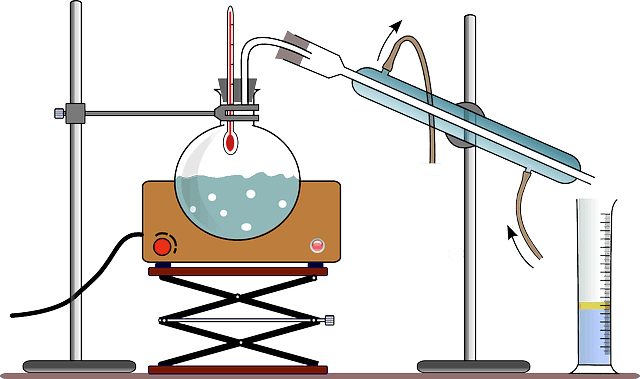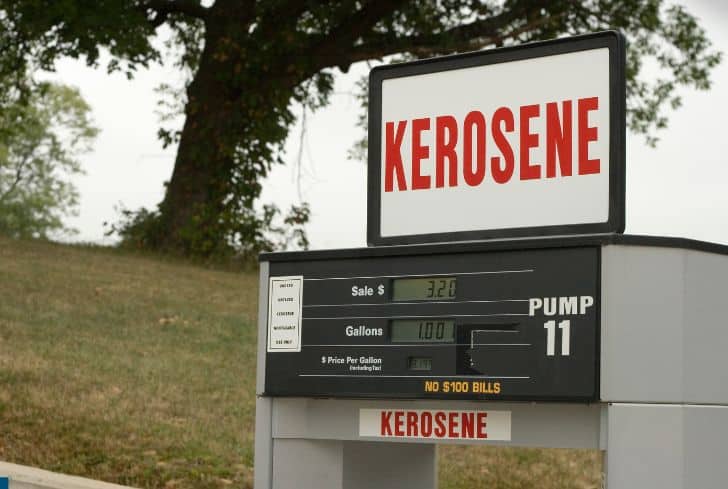Does Kerosene Freeze? (And At What Temperature?)

Most people on earth use kerosene for daily activities. Some people use kerosene to heat their homes, run stoves, run massive power equipment, and light lamps. If you use kerosene for any of the mentioned purposes, there’s a chance you’ll buy it in bulk for storage. But in the winter, you are worried because you are unsure whether your kerosene will freeze. So, does kerosene freeze?
In this article, we will provide a solution to your question. Perhaps you’d also like to know if you can use kerosene at any temperature or if it freezes into blocks if you store it in the freezer. Also, learn if it gels during the winter and whether kerosene gets contaminated.
Read: Does Kerosene Go Bad?
Will Kerosene Freeze?
Kerosene won’t freeze until outside temperatures fall to -40°F or lower. You don’t need to be concerned about kerosene freezing unless you live somewhere where the temperature drops below this level. In addition, kerosene itself is a blend of several hydrocarbons derived from petroleum and other substances.
Kerosene is made up of several chemicals that freeze at various temperatures. Different temperatures of its compounds make the freezing point for kerosene vary.
Kerosene may be represented chemically with the molecular formula C12H26−C15H32.
Keep kerosene in clean, airtight containers if you’re storing it. Kerosene will continue to be stable as long as the temperature doesn’t drop below -40°F.
Does Kerosene Freeze in Winter?
Kerosene does not freeze in winter. Not unless you live somewhere where the winter temperature drops below -40°F. Kerosene will, however, freeze in the winter if exposed to extremely low temperatures, and the storage container contains water beads. In the winter, uncontaminated, pure kerosene won’t freeze.
However, if you intend to store kerosene over the winter, it may thicken and become difficult to pour. However, it won’t freeze. You should store kerosene properly to prevent contamination.
Here is how to store kerosene properly:
What Temperature Does Kerosene Freeze?
Kerosene freezes at a temperature of -40°F. Kerosene will therefore freeze if it is intended to be stored in unheated storage space and the outside temperature approaches that. Kerosene does, however, exist in several grades. The standard kerosene sold in stores has a freezing point of -40°F. Different freezing points are found in the other kerosene grades. One example is aviation kerosene, which freezes at –60 °F.
Also, kerosene has been treated with additives to prevent freezing. It has a freezing point of around -100°F.
Can Kerosene Block in the Freezer?
Under normal conditions, kerosene will not block in the freezer. A domestic freezer’s freezing point is between -18 and -20 degrees Celsius, while a commercial freezer is between -18 and -36 degrees Celsius. Kerosene cannot freeze in the freezer since its freezing point is between -40C and -50C unless the temperature in your freezer drops below that level.
Can You Use Kerosene at Any Temperature?
Kerosene has a flash point that ranges from 37 and 65 °C. The temperature at which a substance releases sufficient vapor to ignite when in contact with an ignition source. Kerosene use becomes highly hazardous when the temperature rises above 37 °C. If you store kerosene in an open container on a hot day, it will most likely get hot enough to ignite.
You should not try to use kerosene at any temperature close to or above its flashpoint. Kerosene is flammable. Kerosene will produce flammable vapors above 36 °C that will easily ignite if an ignition source, such as a cigarette lighter, is introduced.
Kerosene shouldn’t be used if there are frequently hot days with temperatures higher than 36 °C where you live. Though compared to other fuels such as petrol, kerosene is less volatile. Petrol is more flammable; at around -43 °C, it begins to release volatile fumes. Kerosene is hence less volatile and safer to use than gasoline.

Does Kerosene Gel in Cold Weather?
When it’s frigid outside, kerosene doesn’t gel. Kerosene burns cleaner thanks to its proper refining process. Gelling is the process through which a fuel turns solid and stops flowing. By this time, the fuel has cooled to a point where enough wax crystals have developed to prevent further movement. Rarely will kerosene reach the temperatures necessary for the wax crystals to form.
When the outdoor temperature drops below -32 degrees Fahrenheit, gelling takes place. Any fuel with a lower freezing point will begin to gel. The freezing point of kerosene is 40 °F.
Is It Bad to Store Kerosene Outside in the Winter?
Several factors will determine whether kerosene stored outside throughout the winter is a good idea. If you have a way of keeping your kerosene from freezing by storing it in heated spaces, there is no problem. Additionally, it depends on where you live. Very few places will go below -40°F during the winter. Only a few cities reach this freezing level.
You can happily store kerosene outside if your area does not drop below such temperatures. You can store kerosene outside in the winter if you buy aviation kerosene or treated kerosene. Should you decide to keep kerosene outdoors during the winter, it should be in a metal container that is tightly closed and marked. Ensure your kids cannot get to the storage area.
Knowing how to store kerosene outside safely is essential as it would be hazardous to store it indoors. You should not keep kerosene where it can easily catch fire since it is flammable. Don’t store kerosene in an area where it will come into contact with other incompatible substances to avoid chemical reactions.
Does Kerosene Go Bad?
Yes, kerosene does go bad. Kerosene has a shelf life of five years if you store it properly. Unfortunately, there is a possibility of water getting added to the kerosene through condensation. Water in kerosene leads to the growth of bacteria and mold, resulting in kerosene breaking down. When kerosene breaks down, it eventually goes bad.
How, then, do you determine if your kerosene is bad? Follow the highlighted steps:
- Take out a small amount from the bottom of the container. The bottom of the container is where most oil contaminations are present.
- Place the sample in a small clear jar, and let it sit for at least an hour.
- Look closely to check whether particles or water bubbles are floating in the kerosene.
- The kerosene is bad if you can see particles or water bubbles or observe that the kerosene is cloudy or has a yellowish appearance.
You can also test to see if kerosene has gone bad by burning a small amount. If the kerosene flame is bright and even and its odor faint, your kerosene hasn’t gone bad. The presence of sludge at the bottom of the kerosene container indicates the kerosene has gone bad.
How Can You Handle Kerosene Safely?
Knowing how to handle kerosene safely is essential if you’re a frequent user. The risk of causing a fire is high, and it is poisonous. Breathing in kerosene vapors is poisonous for people and animals. So if you will be handling kerosene, here are the tips you should follow:
- Kerosene must be kept in its original container for indoor and outdoor refilling.
- When handling kerosene, ensure always to wear safety goggles and gloves.
- Don’t move or leave kerosene unattended when you light a kerosene lamp or heater.
- Kerosene should have adequate ventilation in every room used to prevent the buildup of carbon monoxide.
- Kerosene should never be disposed of in the trash or down the drain. The majority of places have rules for disposing of hazardous waste.
Frequently Asked Questions
Does Kerosene Evaporate?
Kerosene does evaporate at room temperature, though very slowly. Spilling kerosene on any surface can stay there for a very long period if you don’t clean it. Even after wiping, kerosene will leave a powerful smell that will last a long time. Here are some ways to remove kerosene from different surfaces as the standard methods won’t work:
1. Use sand to soak up the spillage and a very strong spillage afterward. Don’t use a lot of water when cleaning to avoid spreading kerosene.
2. Use a sponge to soak up kerosene and then clean with a strong detergent.
3. Machine wash or apply a mixture of baking soda and water if kerosene spilled on a fabric that soaked it up. Or apply some vinegar.
Can Kerosene Burn Underwater?
Underwater, kerosene cannot burn. For a fire to burn, oxygen is necessary. When it is underwater, kerosene will no longer have access to air, which is the source of oxygen. Kerosene can, however, burn on top of the water. It will float on water after being lit and continue to burn in oxygen.
Because of this, it is not recommended to use water to put out a kerosene fire. Kerosene will probably disperse into little pools of water, where it will continue to burn. Water spreads a fire.
Conclusion
If you want a more dependable heat source during the winter, consider using kerosene. It is possible to store it outside throughout the winter because it does not freeze, gel, or create ice blocks. However, that is only possible provided the winter lows in your area do not go below -40°F. Kerosene is flammable. Thus, you should avoid using it in temperatures higher than 36 °C.
When you store kerosene, ensure that you check on it frequently because it can spoil.





